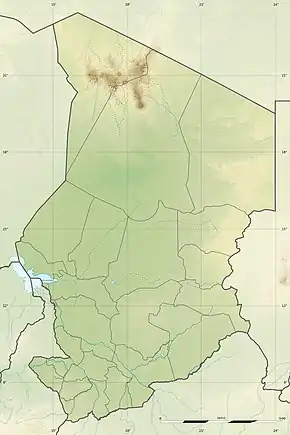Battle of Fada
The battle of Fada took place in northern Chad in 1987, and was a turning point of the Chadian–Libyan conflict.[2][3]
| Battle of Fada | |||||||
|---|---|---|---|---|---|---|---|
| Part of Toyota War | |||||||
| |||||||
| Belligerents | |||||||
|
|
| ||||||
| Commanders and leaders | |||||||
|
| Hassan Djamous | ||||||
| Strength | |||||||
|
1,200 Libyan soldiers[1] 300-400 CDR militia | 3,000 soldiers | ||||||
| Casualties and losses | |||||||
|
784 killed 81 captured 92 tanks destroyed 33 armoured vehicles destroyed 13 tanks captured 18 armoured vehicles captured |
18 killed 3 trucks destroyed | ||||||
 Location within Chad | |||||||
Prelude
At the beginning of 1986 the Libyans controlled all Chad north of the 16th parallel. However, when France intervened in the country in Operation Sparrowhawk and Goukouni Oueddei's and his People's Armed Forces rebelled against his former supporter Muammar Gaddafi, Libya's President, the situation became critical for the Libyan army and promising for Chad's President Hissène Habré.
Certain that the French would protect Chad south of the 16th parallel, Habré started assembling his army, the Chadian National Armed Forces (FANT), at Kalaït, a logistic deposit built by France exactly at the 16th parallel, and which it had stocked with munitions, weapons and fuel. France and the United States had equipped the FANT with a large number of Toyota pickups, and antitank and antiaircraft missile launchers, such as MILAN ATGWs. The FANT assault under the command of Hassan Djamous deployed almost 3000 soldiers for the coming battle.
Battle
This powerful force attacked Fada, the capital of the Ennedi and a Libyan stronghold, on 2 January 1987. Hassan Djamous took the 1,000 Libyan soldiers and the 300–400 members of the Democratic Revolutionary Council (CDR) militia by surprise. In a short but brutal engagement the FANT almost annihilated the Libyan armoured brigade that defended Fada: 784 Libyans and CDR militiamen died, 92 T-55 tanks and 33 BMP-1 infantry fighting vehicles were destroyed, and 13 T-55s and 18 BMP-1s captured, together with 81 Libyan soldiers. Chadian losses were minimal: only 18 soldiers died and three Toyotas were destroyed.
This was one of the first major combat victories employing the tactic of using light trucks armed with machine guns or rockets, later known as "technicals." This tactic mirrored the actions of the raids conducted by the Long Range Desert Group of World War II, but on a slightly smaller scale theater, against slightly less numerous enemies, but with more modern weaponry and equipment.
Although the Chadian commander's tactical ability played an important role in the victory, the anti-tank missiles were decisive. When combined with the superior maneuverability of the Toyotas, they proved their efficacy against the Libyan tanks.
Aftermath
On 3 and 4 January the Libyan Air Force sent several waves of bombers to Fada in an attempt to destroy the captured equipment and ammunition. Still, these could not change the essential fact that Libya had suffered a major defeat that was to prove the beginning of the end of the Chadian-Libyan War.
References
- Pollack 2002, pp. 391
- Pollack 2002, pp. 391–392
- S. Nolutshungu, p. 216
Bibliography
- Nolutshungu, Sam C. (1995). Limits of Anarchy: Intervention and State Formation in Chad. University of Virginia Press. ISBN 0-8139-1628-3.
- Pollack, Kenneth M. (2002). Arabs at War: Military Effectiveness, 1948–1991. University of Nebraska Press. ISBN 0-8032-3733-2.CS1 maint: ref=harv (link)
External links
- Operation Epervier (in French)
- Libyan Wars